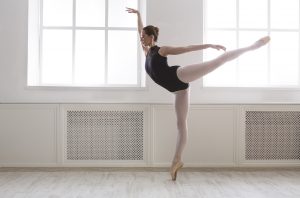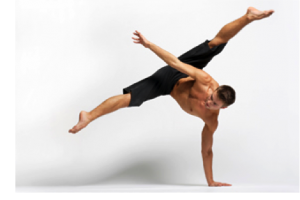
A great dancer looks effortless, but graceful movement requires incredible strength, flexibility and stamina. It also comes with a high risk of injury. Whether you are a dancer, the parent of a dancer or a dance teacher, being aware of common dance injuries is important.
Up to 90% of dancers will sprain their ankle once in their lifetime. High-level dancing involves a number of difficult manoeuvres involving jumps, landings, twists, and lifts with partners. Failure to perform these movements correctly can lead to acute injuries to the foot and ankle. Many traumatic injuries result from the loss of balance during landing from a jump, commonly resulting in a midfoot sprain. Dancers frequently do complex spins in the air and must decelerate and stop rotation suddenly on landing. The Anterior Talofibular ligament is the ligament most commonly injured. Once you’ve sprained your ankle, you are at risk of doing it again. It’s important to build muscle strength to prevent further injuries. Physiotherapist can help to correctly diagnose the severity and get you on track with a specific exercise program. Delayed treatment can result in unsatisfactory results.
The knee is vulnerable to injuries that range from mild to severe. Landing from a jump, twisting and rotation in dance to improve turnout and other manoeuvres place dancers at risk for meniscus (cartilage) damage/tears. Another likely cause of knee pain in dancers is Patellofemoral pain (PFPS). Typically, dancers will notice pain during class, especially with jumps and/or squatting. The knee may begin to swell at the kneecap and may start to become painful with stairs and sometimes after sitting for a long time. Overuse during training and technique or mechanical faults by the dancer can aggravate PFPS.
 3. BACK PAIN
3. BACK PAINBack pain and aches are extremely common in dancers. It is hard to say exactly what the cause is due to different styles of dancing. Possible causes could be fatigue, hypermobility (where you have a lot of movement at your joints), awkward postures, jumps and repetitive movements. Physiotherapists can help to address the issue with manual therapy and exercise prescription. Core and hip strengthening exercises like Pilates and stability-based Yoga are great for dancers. Aerobic and cardiovascular activities, such as running, swimming or biking, help to build stamina for long performances
 Dancing can cause intense range of motion at joints in certain moves. The hamstring muscle group is a common area for a muscle strain in dancing. Dancers work the hamstrings in almost every movement of the lower body making it very easy to overload and tear. Hamstring strains can have you out for 6-8 weeks depending on the severity and management!
Dancing can cause intense range of motion at joints in certain moves. The hamstring muscle group is a common area for a muscle strain in dancing. Dancers work the hamstrings in almost every movement of the lower body making it very easy to overload and tear. Hamstring strains can have you out for 6-8 weeks depending on the severity and management!
With any injury it is important to seek professional advice, assessment and management at the first signs of the symptoms to make sure there is no further damage.
Initial treatment usually involves rest and ice followed by an early rehabilitation/exercise program provided by your physiotherapist before returning to dance. Return to dancing exercise programs developed by the physiotherapist will include specific movements/dance poses that are relevant for the dancing style. We ensure each dancer can meet the dancing requirements before returning.
Stability based Yoga and Pilates is a great add on for dancers to incorporate into their regime. Often dancers can move into deep ranges of motion throughout their entire body yet may lack stability to support these structures. It is essential to create a stabilised and strong body in order to prevent injury.
Our physio’s are available to do Pointe Assessments, or assist with your dance related injuries.